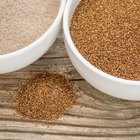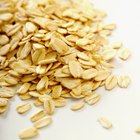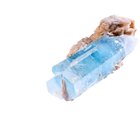
The differences between red and white wheat are not very pronounced and are based on the bran color, which contribute to the identifying wheat color. The absence of bran color results in a flour that is slightly sweeter. The greatest difference between grains is actually between soft and hard wheat. The varying protein content levels result in very different uses.
Hard Red Winter Wheat
Primarily known as Kansas City wheat, this grain comprises the majority of all wheat species grown in the United States. The trading of wheat futures occurs in the largest city of the region where the wheat is grown and is why the name Kansas City is applied to this type of wheat. Grown on 23 million acres, spanning the Great Plains and Texas to Montana and the Dakotas, this wheat accounts for 40 percent of all wheat grown in the United States.
Because of its high protein levels, hard red winter wheat generally is milled to create all-purpose flour, which is a combination of hard and soft wheat flour. It also is used to create bread flour because its high gluten strength and protein levels work well with yeast products.
Hard Red Spring Wheat
Primarily known as Minneapolis wheat, hard red spring wheat is grown on 13.8 million acres in Minnesota, Montana and the Dakotas, this grain has the highest protein content of all wheat classes.
Like hard red winter wheat, hard red spring is milled to create all-purpose and bread flours. There appears to be little difference between hard red spring and hard red winter wheat when baking.
Soft Red Winter Wheat
Primarily known as Chicago wheat, this grain is grown on 13 million acres primarily east of the Mississippi River. It has a low protein content. This characteristic results in baked goods that crumble more and crisp greater than wheat flours of a higher protein content.
When you purchase all-purpose whole-wheat flour anywhere in the United States, it will be a combination of either hard red winter or hard red spring wheat and soft red winter wheat. Because of its low protein content, it is also milled to create cake flour (when it is bleached), pastry flour and self-rising flour (when leavening and salt are added). Flours containing soft red wheat are generally used when baking flat breads, crackers, cakes and pastries.
Hard White Wheat
This wheat is a relatively new grain. It was introduced to the U.S. agricultural system in 1990 and covers only 300,000 acres. It resembles hard red wheat in all characteristics with the exception of missing genes that create the red bran coloring. This results in a wheat that is sweeter and more mild than red wheat flour, which some find to be slightly bitter.
As it resembles red wheat in all characteristics except for color, hard white wheat is also milled to create all-purpose flour and bread flour.
Soft White Wheat
This wheat carries the same characteristics as soft red wheat, though it lacks the red color and is sweeter because of it. This grain covers 8.3 million acres in the Pacific Northwest, California, New York, Michigan and Wisconsin. Soft white wheat is exported to Asia, where it is used to create noodles.
Soft white wheat carries the same characteristics as soft red wheat, except for bran color, and is milled to create all-purpose flour, cake flour (when it is bleached), pastry flour and self-rising flour (when leavening and salt are added). When buying all-purpose white flour anywhere in the United States, it will be a combination of hard white wheat and soft white wheat.
Related Articles

Hard White Wheat Vs. Hard Red Wheat

What Is the Difference Between Cake ...

Alternative Flours to Make Pizza

Is Teff Flour Gluten-Free?

Is Unbleached Flour the Same as ...

What Kind of Flour Do You Use for a ...

Difference Between Red Rice & Brown Rice

How to Identify Red Jasper

Baking With Oats Instead of Flour

How Long Do I Cook Vermicelli?

What Additives Are in Flour?

Kamut Vs. Wheat

Is Jasmine Rice Naturally White or Is ...

How Is Wheat Processed?

List of the Types of Semi-Precious ...

How to Make Pumpernickel Flour

Substitute for Gram or Besan Flour

Does Cake Flour Contain Baking Soda & ...

How to Replace Wheat

Difference Between Sebastian ...
References
Writer Bio
Kate Barber has been working as a freelance writer for over five years and currently lives in Santa Barbara, California. She worked as a writer for "Humanus," a journal on human rights, and is a graduate of New York University with a Master of Arts degree in economics.
Photo Credits
Wheat image by Andruxa from Fotolia.com